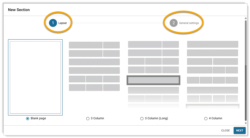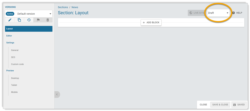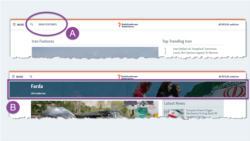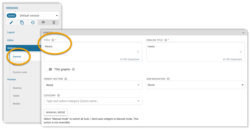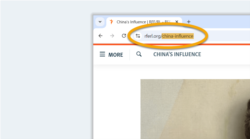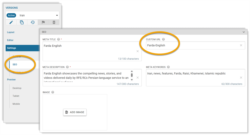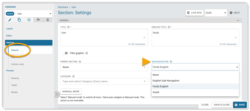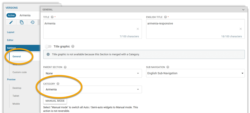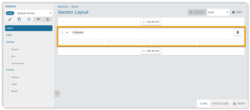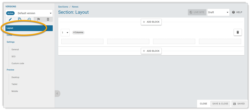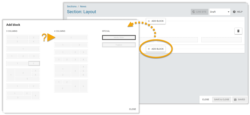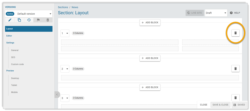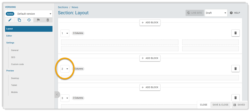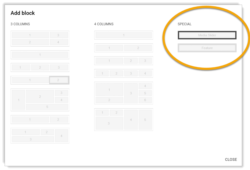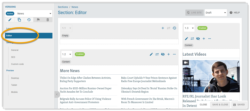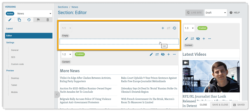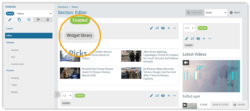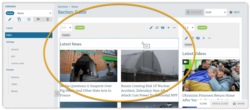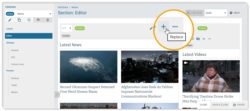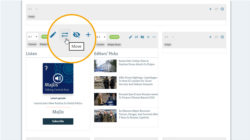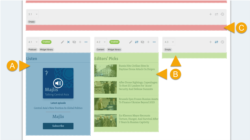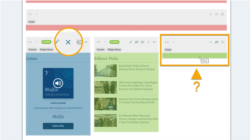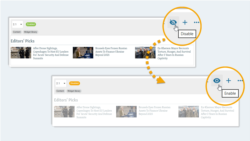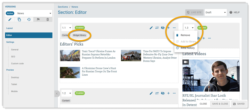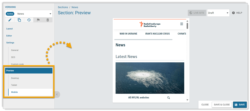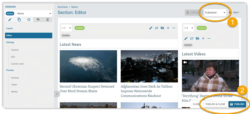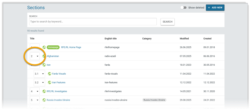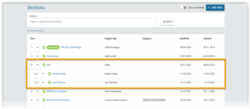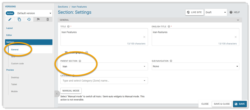What's inside this article:
- Basic information
- Get started
- Set the page title
- Boost SEO (Search Engine Optimization)
- Add a Custom URL
- Add a Sub navigation
- Merge the Section with a Category
- Add and manage layout blocks
- Add and manage widgets
- Preview the Section
- Publish the Section
Basic information
This article explains how to create Sections in Pangea CMS.
What is a Section?
A Section is a collection of Widgets are interactive content blocks, used to build Sections and other components on Pangea websites. They can promote content pages, live streams, newsletters, podcasts, and more. Pangea offers several widget types, each serving a different purpose. Learn more., dedicated to sharing the latest news and stories on a particular topic (such as sports, economics, or politics).
You can create two types of Sections:
- Standalone Sections are independent pages. Your homepage is an example of a standalone Section.
- Merged Sections are not independent pages. A merged Section is merged with a Category and appears on the Category page above the content list.
If you are creating a merged Section to display on a Category page, refer to our guidance on how to create these Sections:
Get started
To start creating a new Section:
- Go to Build > Sections.
- Select + Add new.
On the New Section dialog, you need to perform the following actions:
- Layout: Select the starting layout for your new Section.
- General settings: Provide titles in your local website language and in English.
Find more details below:
After you hit Add, the edit page for your new Section opens.
The new Section is saved with the Draft status. While it has the Draft status, the Section is saved internally in Pangea CMS but is not accessible on the public site.
The remaining chapters in this article describe the most important steps for creating and publishing a new Section:
- Set the page title
- Boost SEO (Search Engine Optimization)
- Add a Custom URL
- Add a Sub navigation
- Merge the Section with a Category
- Add and manage layout blocks
- Add and manage widgets
- Preview the Section
- Publish the Section
Set the page title
For each standalone Section page, you can choose one of the title options below:
- (A): Standard title: A simple text title.
- (B): Title graphic: A full-width graphic that shows the page title over a background image.
For both title options, provide the title text via General > Title. Try to keep the title as short as possible. (1-3 words should be sufficient in most cases.)
If you want to display a Title graphic, enable the Title graphic slider. For detailed instructions on how to configure a Title graphic, visit the following article:
Boost SEO (Search Engine Optimization)
Go to Settings > SEO to add the Metadata is descriptive information, which helps search engines to understand and categorize the content on a page. It is not displayed on the page itself, but search engines might show the meta title and meta description on results pages. This data helps users on search engines to decide whether to open the page. for the Section.
You will not be able to save a new Section (standalone or merged) until you add the following required metadata:
- Meta title
- Meta description
Find detailed information about all the settings below:
We also recommend adding a Custom URL for all standalone Section pages.
Add a Custom URL
A Custom URL is a short piece of human-readable text (normally 1-3 words) that replaces the numerical ID in a page URL.
Custom URLs offer the following main benefits:
- Descriptive URLs tell users where they will go after clicking a link.
- URLs that include keywords might rank more highly on search engine results pages.
- Consistent use of descriptive, user-friendly URLs boosts the authority of your domain for search engines.
For a standalone Section, create a Custom URL via SEO > Custom URL.
For detailed information, including tips and best practice, visit the following article:
Add a Sub navigation
A Sub navigation is a horizontal collection of links, which appears directly below the site header. These prominent links provide quick access to key pages.
To add a Sub navigation to a standalone Section page:
- Go to General > Sub navigation.
- Select a Sub navigation from the list.
The selector shows the available Sub navigations for your site. To create a new Sub navigation, go to the separate Sub navigation page in Pangea CMS. For instructions, visit the following article:
Merge the Section with a Category
You can create two types of Sections:
- Standalone Sections are independent pages. Your homepage is an example of a standalone Section.
- Merged Sections are not independent pages. A merged Section is merged with a Category and appears on the Category page above the content list.
If you are creating a merged Section to display on a Category page, refer to our guidance on how to create these Sections:
To merge a Section with a Category:
- Go to General > Category.
- Select a Category.
The following conditions apply:
- You can only select one Category.
- You cannot select a Category that is already merged with another Section.
- You can only select a Content Category that uses the List with images layout.
For detailed information about merging Sections and Categories, visit the following article:
Add and manage layout blocks
Layout blocks provide the underlying structure for your Section. Each block runs horizontally across the page width and includes one or more areas for displaying widgets. One area can display one widget. For example, the block below has four areas and can display four widgets.
To add and manage layout blocks, select Layout in the left panel.
The following actions are available:
Add and manage widgets
Widgets are interactive content blocks, used to build Sections and other components on Pangea websites. Widgets can promote content pages, live streams, newsletters, podcasts, and more. Pangea offers several widget types, each serving a different purpose. For an overview of the available widget types, visit the following article:
To add and manage widgets, select Editor in the left panel.
Two options are available for adding a new widget to a Section:
For existing widgets, several actions are available:
- Edit a widget
- Replace a widget
- Move a widget
- Disable / enable a widget
- Delete / remove a widget
To learn more about these actions, go to the following section:
Create a new widget
You can create a new An independent widget is an isolated widget instance, used in just one place on your website. Edits to an independent widget do not impact other widgets, and independent widgets do not inherit updates from other widgets..
To create a new independent widget in an empty area:
- Select an empty area.
- Ensure New widget is selected. Then, select the type of widget you want to create.
The widget edit page opens in the same tab. To learn about the widget settings, visit the relevant article below (according to the type of widget):
Content | FactCheck | HTML | Live stream | Manual stream | Multimedia | Podcast | Poll | Subscription | Trends
Use a library widget
The Section can display an existing library widget from the The Widget library is a collection of ready-to-use widgets. Widgets saved in the Widget library are known as "library widgets". One library widget might be used in multiple places across your website. Learn more..
To display a library widget in an empty area:
- Select an empty area.
- Select Library widget. Then, search for and select the widget you want to use.
Your selected library widget is now displayed in the area. On the Editor subpage in Pangea CMS, library widgets are marked with the Widget library badge.
To learn more about library widgets, visit the following article:
Manage widgets
For existing widgets, the following actions are available:
Preview the Section
Before you publish a new Section, check how it will look on the website. Choose your preferred option under Preview in the left panel:
- Desktop: Check how the Section will look when viewed on a desktop computer.
- Tablet: Check how the Section will look when viewed on a tablet.
- Mobile: Check how the Section will look when viewed on a mobile device.
The preview includes unsaved changes. You do not need to save changes before checking them in the preview.
NOTE: For merged Sections, the preview shows the Section as a standalone page. You do not see how the Section will look on the Category page.
Publish the Section
To publish a new Section:
- Select Published in the status selector.
- Hit Publish / Publish & close.
The Section is now published.
You can visit the page and retrieve the URL for the new Section using one of the methods below:
- On the Section edit page, hit the Live site button.
- On the Sections list, hover over the panel and hit the Live site button.
NOTE: If the Section is merged with a Category, the Section URL redirects to the Category page URL.
By default, your new Section appears at the bottom of the Sections list. If you want to move the Section, two options are available:






